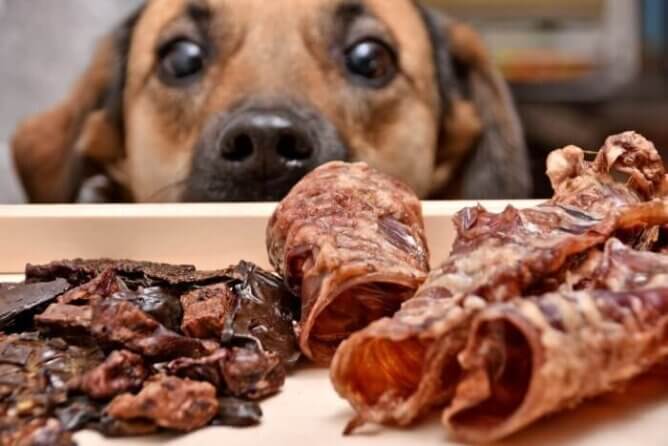
DogFoodAdvisor is reader supported See how
Dog Food Advisor is 100% impartial and is never paid to promote any brand. But if you buy using links on this page, we may earn a referral fee.
First things first, what exactly is offal?
Offal is simply a more tasteful term for organ meats, similar to how beef is used for cow meat. It’s an attempt to avoid the ‘yuck’ factor or the squeamish image people have of hearts and livers on their dinner plates.
But despite some misconceptions about offal, it has the potential to be a superfood for your beloved furry friend (you, too, but that’s for another website to talk about).
In this article, we’ll digest the world of offal (or organ meat if you prefer), its benefits for dogs, and ways to incorporate it into their diets.
Are Organs Really Edible?
While the U.S. primarily harvests livestock for their muscle meat, in countries like France, Mexico, and China, offal is a staple in traditional meals. In fact, organ meats from grass-fed, full-pastured animals are some of the most nutrient-rich foods you can eat.1
People are often offended by the thought of buying organs and feel nauseous at the idea of consuming them. Nonetheless, there is growing interest in the health benefits of organ meats, even labeling them as superfoods for both humans and pets.
What Makes Offal a Superfood for Dogs?
“Offal is an inherently nutrient-dense food which contains a whole host of vitamins and minerals beneficial to health,” says Laura Ward, DFA’s nutritionist. “The nutrients within different organs and species vary, but in common is the nutrient richness and that offal is hugely palatable for dogs.”
Compared to regular cuts of muscle meat, offal is packed with a range of essential nutrients like vitamins A, B, and D, as well as vital minerals such as iron, zinc, and selenium.2 These nutrients are pivotal for your dog’s overall health and well-being.
Such nutrients can help keep your dog’s blood cells healthy, boost their immune system, aid in quicker healing if injured, repair tissue, and help maintain strong bones.
One of the key differences that makes offal more important for pets is the inability of dogs and cats to synthesize vitamin D3 from sunlight.3 Meaning that dogs rely on their food to get this essential vitamin and offal is an excellent addition to the diet for a hit of vitamin D.
Growing animals in particular have higher requirements for nutrients like iron, selenium, and copper than we do, which are far more abundant in organ meats than other dietary sources. It can be difficult to supply these minerals consistently and in adequate quantities without utilizing such meats that we two-leggeds so often turn our noses up at.
Commercial Dog Food and Offal
Dog food that is complete and balanced to meet AAFCO nutritional profiles should already contain the necessary vitamins and minerals for a balanced diet. Offal is just another natural nutritional boost that mimics the diet of their ancestors.
“In fact, it’s standard practice for offal to already be included in commercially made dog food,” says Laura. “Therefore your dog is highly likely to be already eating offal if they are eating a fresh animal or fish commercially made food.
“It is an incredibly nutritious ingredient, which is wildly appetizing for pets and is in many countries a by-product of muscle meat preparation which has little demand for human food.”
Often these organs aren’t explicitly identified so if the label on your dog’s food doesn’t have a term such as ‘liver’ or ‘heart’ on it, this doesn’t necessarily mean offal is absent. If you are keen to know the offal content, it’s a good idea to reach out to your dog food supplier and ask them.
What About Offal in Raw Dog Food?
In raw foods, offal is often more clearly stated due to the different feeding styles. For example, the ‘prey’ model is 80% meat, 10% bone, 10% organ, and so people are eager to see organs listed in an ingredients list.
If you’re interested in the raw diet or introducing it as a topper to your pet’s kibble, you can read more about it here.
Best Organ Meats for Dogs
If you’re wondering what type of offal could be in your pet’s food, these three organ meats are likely to be the most common and readily available:
- Liver: liver is packed with protein, vitamins (such as vitamin A, niacin, folate, riboflavin), and essential minerals like iron and zinc. It’s also rich in nitrogen-containing compounds.
- Kidney: kidney meat is another protein-rich option. It’s a valuable source of vitamin B12, iron, folate, thiamin, niacin, and riboflavin.
- Heart: heart contains iron, zinc, and thiamine, and it’s the best natural source of coenzyme Q10. It’s also rich in collagen and elastin, vitamin B12, potassium, selenium, and phosphorus.
While the above organ meats are the most common, you can also feed your dog a range of offal including gizzards, tripe, tongue, spleen and even brains are nutritious and suitable for dogs.
As mentioned, your dog is likely to be already eating offal in their food, but you can also find it in treats. Organ meats are becoming more and more popular in treats due to their palatability and nutrient density. It’s not unusual to see dried beef liver or tripe on offer. A delicious reward for your good boy or girl.
How to Prepare Organ Meat for Dogs
As mentioned, most dog food these days — especially raw dog food — contains organ meat, so you don’t need to do anything to prepare it other than give it to your dog.
If you’re thinking about buying organ meat such as liver, kidney, heart or offal from your butcher, you may be wondering how to feed it to your dog.
You can give organ meat to your dog raw or cooked, although raw is thought to preserve more nutrients. It may help to whizz the meat up in a food processor so you can portion it out and freeze some if there’s an abundance of offal.
As always with raw meat, ensure you wash your hands and any kitchen equipment or surfaces that come into contact with the meat thoroughly after use.
What Pet Parents Need to Know About Adding Offal to Their Dog’s Diet
Balance is key when it comes to offal into your dog’s diet. While it’s highly nutritious, it shouldn’t dominate their meals. As mentioned, sourcing nutritionally balanced dog food should be enough to satisfy your dog with the necessary vitamins and minerals.
Balancing organ meat is crucial because some nutrients can be in excess. This is particularly true for vitamin A in liver and thyroid hormone in trachea. It’s important not to feed lots of offal to your dog as it could lead to a vitamin overdose.
If you are interested in adding extra offal to your dog’s diet, it’s best to consult your vet or a pet nutritionist to ensure your dog’s diet remains balanced.
Myths and Misconceptions About Offal
Liver is often considered one of the best offal options, but many people worry about toxins, unappealing textures, and smells. In reality, the liver’s primary role is to filter toxins out of the body, not store them. Once you move past the yuck factor, your dog (and maybe even you) will love liver as much as the next meat.
As offal is often given to dogs raw, questions about organ meat and the raw diet often come hand in hand. But if sourced correctly, there is no reason why you can’t feed your dog raw offal.
As explained, organ meat does contain essential nutrients but many people perceive this as offal being an essential ingredient. As nutritious as it can be, offal is not a cure all and it is to be seen as a boost for your pet, not the main dish.
Is Organ Meat good for Dogs?
Offal, or organ meat, may initially sound off-putting, but it’s actually a tasty and nutritious ingredient for your pet (and you).
It’s likely that your furry friend is already enjoying offal in their regular dog food. But it might be worth checking with your supplier just how much they’re eating if you want to introduce more.
While it shouldn’t be the main meal, it can serve as a nutritious ingredient or an occasional treat.
Always consult with your vet before making dietary changes, especially if your dog has existing health issues or deficiencies. This superfood is rich in nutrients, so let’s make sure we super-feed our pets carefully.
Final word
The Dog Food Advisor does not accept money, gifts, samples or other incentives in exchange for special consideration in preparing our reviews.
However, we do receive a referral fee from online retailers (like Chewy or Amazon) and from sellers of perishable pet food when readers click over to their websites from ours. This helps cover the cost of operation of our free blog. Thanks for your support.
For more information, please visit our Disclaimer and Disclosure page.
Article reviewed by
Laura Ward
Pet Nutritionist
Laura studied BSc (Hons) Animal Science with an accreditation in Nutrition at the University of Nottingham, before working for eight years in the pet food and nutrition industry.






